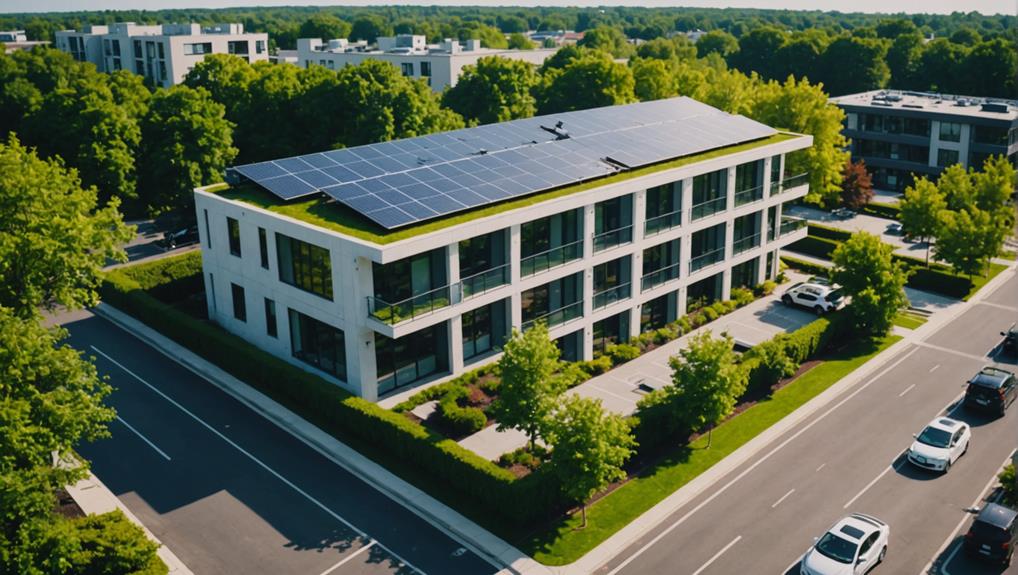Commercial multifamily real estate investing involves generating consistent income through rental payments from tenants in apartment buildings or complexes. This investment strategy demands a thorough understanding of income potential, encompassing rental income, expenses, vacancy rates, and market trends.
Mastering the calculation of Net Operating Income (NOI) and applying the appropriate capitalization rate are essential for assessing profitability and managing risks.
Effective navigation of this complex landscape also requires consideration of financing options, sustainability practices, and legal implications.
What are the strategic benefits and hidden pitfalls associated with this investment approach?
Key Insights
- Commercial multifamily investments provide stable income streams and diversify risk, making them attractive to investors seeking consistent returns.
- Property valuation depends on income potential, utilizing metrics such as Net Operating Income (NOI) and capitalization rate (cap rate) for precise investment assessments.
- Conducting thorough market research, including trends and economic indicators, is essential for making informed decisions in commercial multifamily real estate.
- Various financing options are available, including traditional bank loans, private equity, government-backed loans, and crowdfunding platforms.
- Implementing sustainable development practices, such as energy efficiency and green certifications, can enhance long-term property value and attract investor interest.
Overview of Multifamily Real Estate

Multifamily real estate encompasses residential properties with multiple housing units, such as apartment buildings and townhouses, all under a single roof. This sector provides investors with the opportunity to generate consistent rental income from a variety of tenants.
Accurate property valuation is critical for determining the potential profitability of these investments. Conducting thorough market research enables investors to comprehend local demand, rental rates, and competition, fostering informed decision-making.
Analyzing cash flow is essential for assessing the property's financial performance, considering rental income, operating expenses, and vacancy rates.
The increasing demand for multifamily properties is driven by factors such as population growth, urbanization, and lifestyle shifts. As a result, multifamily real estate remains a compelling investment avenue, balancing risk and reward through diversified rental streams and operational efficiencies.
Benefits of Multifamily Investing

Investing in multifamily real estate offers a variety of substantial benefits. One key advantage is the higher income potential from multiple rental units within a single property. This structure not only maximizes revenue but also makes maintenance more cost-effective due to economies of scale, which reduce overall expenses.
Additionally, the risk is diversified across multiple units, mitigating the impact of vacancies and economic downturns, thereby ensuring more stable income streams. Multifamily properties also provide stronger negotiating power with suppliers, potentially leading to cost savings. Shared amenities further decrease individual maintenance costs, enhancing the overall investment value.
These factors collectively make multifamily real estate a compelling choice for investors.
Key Market Trends

Several critical factors are shaping key market trends in commercial multifamily real estate. Urban multifamily developments are experiencing a surge in demand due to demographic shifts and evolving lifestyle preferences.
Sustainable development practices and the integration of smart technologies are essential components driving this sector forward.
Economic cycles also play a significant role in influencing market dynamics.
Rental Demand Drivers
Rental demand for commercial multifamily properties is rising in major metropolitan areas, driven by increasing urbanization and demographic shifts. Key factors include a growing preference for urban living, lifestyle choices, and the need for affordable housing.
Millennials and baby boomers are increasingly choosing rental living for its flexibility and convenience. Modern amenities such as smart technology, sustainability initiatives, and community spaces are also essential in attracting tenants.
- Urbanization: Population growth in cities boosts demand for multifamily units.
- Demographic Shifts: Both millennials and baby boomers show a preference for renting.
- Lifestyle Preferences: Demand is driven by the desire for convenience and flexibility.
- Amenities: Features like smart technology and community spaces are key to attracting tenants.
Economic Impact Factors
Understanding the economic impact factors in commercial multifamily real estate is crucial for making informed investment decisions. Key market trends such as job growth, population trends, and local economic conditions significantly affect property values.
Analyzing location is essential; regions with strong job markets and favorable demographic shifts, like millennials entering the rental market, often experience higher demand. Economic indicators—including interest rates, inflation, and housing supply and demand dynamics—play critical roles in shaping market conditions.
Monitoring metrics such as occupancy rates, rent growth, and cap rates provides valuable insights into market health. Additionally, comprehending economic cycles, industry trends, and regulatory changes enables investors to navigate the complexities of the commercial multifamily real estate market effectively.
Sustainable Development Trends
Integrating sustainable development practices into commercial multifamily real estate is crucial for long-term economic and environmental gains. The market is transforming with a focus on energy efficiency, green building certifications, and eco-friendly construction materials. Investors increasingly recognize the value of sustainable properties, driven by lower operational costs and higher tenant retention rates.
Key market trends include:
- Green building certifications, such as LEED, attract environmentally-conscious tenants.
- Implementation of solar panels, efficient HVAC systems, and water-saving fixtures minimizes environmental impact.
- Growing demand for eco-friendly construction materials enhances sustainability credentials.
- Long-term benefits like reduced operating expenses and increased property value drive investor interest in sustainable development.
These trends underscore the rising importance of sustainability in commercial multifamily real estate.
Financing Options

Investors exploring financing options for commercial multifamily real estate have a variety of avenues to consider, including traditional bank loans, private equity investments, syndication, government-backed loans, and crowdfunding platforms.
Mortgage financing is a conventional route, offering various loan types such as conventional mortgages and portfolio loans. Private equity funds enable investors to pool resources for substantial acquisitions, promising potentially higher returns.
Crowdfunding platforms offer an innovative alternative, allowing individual investors to participate in large-scale real estate projects. Government-backed loans, like FHA and VA loans, provide favorable terms, making them attractive for secure funding.
Each financing option offers unique benefits and considerations, allowing investors to choose the most suitable strategy for their investment goals.
Property Valuation

Understanding property valuation is crucial for making informed investment decisions in commercial multifamily real estate. Two primary methods in this process are Market Comparable Analysis and the Income Capitalization Approach.
Market Comparable Analysis evaluates a property's value by examining recent sales of similar properties in the area.
The Income Capitalization Approach assesses a property's value based on its potential to generate income, factoring in current rental income and projected future earnings.
These methods provide investors with comprehensive insights into a property's true value.
Market Comparable Analysis
Market comparable analysis is essential for determining the value of commercial multifamily properties. This method involves evaluating similar properties in the area based on key factors such as location, size, age, amenities, and rental income. Such an analysis allows investors to assess the fair market value of a property and make informed investment decisions.
By examining comparable properties, investors gain insights into market trends, pricing strategies, and potential returns on investment.
Location: Proximity to amenities, schools, and transportation influences property value.
Size: Larger properties generally have higher values.
Age: Newer properties often have higher valuations due to modern features.
Amenities: Properties with superior amenities can attract higher rents and valuations.
Market comparable analysis is a vital tool for appraisers, investors, and real estate professionals.
Income Capitalization Approach
The income capitalization approach offers a systematic method to determine the value of commercial multifamily properties based on their income-generating potential. This approach calculates the property's value by dividing the net operating income (NOI) by the capitalization rate (cap rate), which represents the investor's desired rate of return.
By analyzing rental income, operating expenses, vacancy rates, and market trends, investors can assess the property's profitability. This method is crucial for estimating property value to make informed decisions on buying, selling, or refinancing in the commercial multifamily real estate market.
Understanding this approach is essential for accurately evaluating investment opportunities.
Risk Management Strategies

Effective risk management in commercial multifamily real estate investing involves several key strategies: diversification, thorough due diligence, and engaging experienced property management companies.
Diversifying investments across multiple multifamily properties in different markets can significantly mitigate risk. Conducting comprehensive due diligence, including property inspections and financial analysis, helps identify and manage potential risks effectively.
Investing in Class A or Class B properties with stable cash flow reduces investment risk. Engaging property management companies with a strong track record ensures efficient day-to-day operations, minimizing operational risks.
- Diversify investments across different markets
- Conduct thorough property and financial due diligence
- Invest in Class A or Class B properties
- Engage reputable property management companies
These strategies collectively enhance the robustness of a multifamily real estate portfolio.
Sustainability Practices

Adopting sustainability practices in commercial multifamily real estate can significantly improve property value and operational efficiency. Energy-efficient appliances, solar panels, and green building materials align with modern zoning laws and enhance environmental assessments.
LEED certification, a benchmark for sustainable buildings, often requires thorough inspections to ensure compliance. Water-saving fixtures, efficient HVAC systems, and smart thermostats reduce operating costs, while green roofs and rainwater harvesting systems enhance eco-friendly standards.
Recycling programs contribute to a positive community image and attract eco-conscious tenants, further increasing property value. By integrating these sustainable features, investors promote environmental responsibility and achieve long-term economic benefits in the commercial multifamily sector.
Property Management

Property management in commercial multifamily real estate involves overseeing daily operations, maintaining the property, managing tenant relationships, and handling financial responsibilities.
Key areas of focus include:
- Tenant Relations: Building positive relationships to improve tenant satisfaction and reduce turnover.
- Rent Collection: Implementing efficient processes to ensure timely and full rent payments.
- Property Maintenance: Regular upkeep to maintain property value and tenant satisfaction.
- Financial Management: Overseeing budgets, expenses, and financial reporting for informed decision-making.
Effective property management maximizes rental income and maintains high tenant retention rates.
Legal Considerations

Legal considerations in commercial multifamily real estate investing are pivotal for compliance and risk mitigation. It is essential to understand zoning and land use regulations to ensure property usage aligns with local laws.
Lease agreements must also comply with state and federal requirements. These legal frameworks protect investors and foster harmonious relationships with tenants and regulatory bodies.
Zoning and Land Use
Understanding zoning and land use regulations is crucial for developers undertaking commercial multifamily real estate projects. Zoning laws define permissible property uses within specific areas, directly influencing the types of multifamily developments allowed.
Recognizing local zoning classifications—whether residential, commercial, industrial, or mixed-use—helps determine a property's development potential. Land use regulations further govern aspects like density, height, and building design, ensuring projects align with local standards.
Compliance with these regulations is essential for project viability and profitability.
Zoning laws: Define permissible property uses.
Land use regulations: Govern development aspects.
Zoning classifications: Determine development potential.
Regulatory compliance: Essential for project success.
Lease Agreements Compliance
Ensuring lease agreements comply with state laws, local regulations, and fair housing laws is fundamental for successful commercial multifamily real estate investments.
Legal considerations in lease agreements include tenant screening, tenant rights, eviction procedures, lease renewals, and dispute resolution processes. These agreements must clearly outline key terms such as rent amount, payment terms, lease duration, maintenance responsibilities, and tenant obligations.
Compliance with these legal frameworks is vital to maintaining strong landlord-tenant relationships and ensuring smooth property operations. Property owners should draft lease agreements meticulously to meet legal requirements and protect their interests, thereby enhancing the stability and profitability of their investments.
Success Stories

Investor success in commercial multifamily real estate hinges on targeting high return on investment (ROI) properties, optimizing capitalization rates (cap rates), and maintaining a favorable debt service coverage ratio (DSCR). These strategic focuses lead to robust income streams and significant property appreciation.
Key factors contributing to these successes include:
- Stable and Growing Income Streams: Multifamily properties provide consistent rental income, enhancing financial stability.
- Property Appreciation: Strategic acquisitions result in substantial value increases over time.
- Portfolio Diversification: By diversifying real estate holdings, investors mitigate risk.
- Resilience During Economic Downturns: Multifamily properties often remain stable, offering reliable returns even in challenging economic climates.
Together, these elements enhance the profitability and stability of multifamily real estate investments.
Conclusion
Commercial multifamily real estate investing offers a promising avenue for generating income through rental properties. Investors can evaluate the potential profitability of an investment by analyzing factors such as rental income, expenses, and market trends.
Understanding financing options, property valuation methods, and sustainability practices enhances decision-making. Effective property management and awareness of legal considerations are essential for success.
Embracing these aspects can lead to informed investment choices and potentially lucrative outcomes in the multifamily real estate market.





